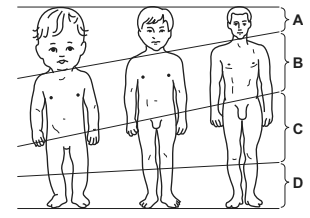Question
What always increases during the development of an organism?
A cell number
B complexity
C dry mass
D volume
▶️Answer/Explanation
B complexity
During the development of an organism, complexity typically increases. As an organism grows and develops, its cells differentiate into various specialized types, organ systems become more intricate, and overall biological complexity increases. While some of the other options (cell number, dry mass, and volume) may also increase during development, complexity is a fundamental characteristic that tends to consistently rise as an organism matures.
Question
Question
The graph is a record of the growth of a plant.

▶️Answer/Explanation
C
For the x-axis (horizontal axis), you should label it as “Time” to represent the duration over which you’re observing the growth of the plant.
For the y-axis (vertical axis), you should label it as “Dry Mass (g)” to represent the amount of dry mass the plant has accumulated. Dry mass is a common measure of a plant’s growth as it removes the variability introduced by water content, providing a more accurate reflection of the plant’s actual growth.
Question
Which environmental factor is not always a requirement for seed germination?
A light
B oxygen
C suitable temperature
D water
▶️Answer/Explanation
Ans: A
“light” is the environmental factor that is not always a requirement for seed germination.
Seed germination is the process by which a seed begins to grow into a new plant. It involves the activation of the embryo within the seed, which starts to grow and develop into a seedling. While water, oxygen, suitable temperature, and sometimes even certain nutrients are generally essential for seed germination, light is not always a strict requirement.While seeds require specific conditions to germinate, not all seeds require light for germination. Some seeds, known as photoblastic seeds, do require light for germination, while others do not.
Question
What may be defined as ‘an increase in dry mass’?
A growth
B nutrition
C reproduction
D respiration
▶️Answer/Explanation
A
An increase in dry mass is typically associated with the process of growth. Growth refers to the increase in size, volume, or mass of an organism over time. When an organism undergoes growth, its cells divide and multiply, leading to an increase in the number of cells as well as the accumulation of cellular material. This accumulation of cellular material contributes to the increase in dry mass.
Dry mass refers to the weight of an organism or a part of an organism after all the water content has been removed. It is a measure of the solid, non-water components of an organism, including proteins, carbohydrates, lipids, and other structural materials. This is in contrast to wet mass, which includes the water content.
Nutrition, reproduction, and respiration are also important processes for living organisms, but they are not directly related to the concept of an increase in dry mass.
Question
The diagram shows a baby, a child and an adult (not drawn to the same scale).
As a baby grows into an adult, which labelled region grows the most?

▶️Answer/Explanation
C
Sexual characteristics and reproductive organs experience significant growth as an individual transitions from a baby to a child and finally into an adult.
During infancy and early childhood, sexual organs are relatively undeveloped and show minimal differentiation between males and females. As a child approaches puberty, a process triggered by hormonal changes, the reproductive organs begin to undergo substantial growth and maturation. This is primarily due to the release of sex hormones such as testosterone in males and estrogen in females.
In males, the testes start producing increased amounts of testosterone, leading to the development of larger and more functional testicles. Additionally, the penis grows in size, and secondary sexual characteristics such as facial hair, body hair, and a deeper voice develop.
